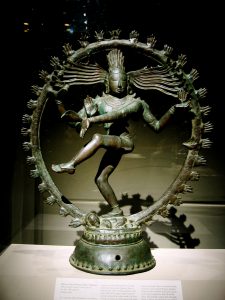NCERT notes on important topics for the UPSC Civil Services Exam preparation. These notes will also be useful for other competitive exams like banking PO, SSC, state civil services exams and so on.
Bronze Sculptures
Introduction
- Apart from sculpturing in terracotta and stone, ancient Indian artists were masters in bronze sculpting as well.
- The Lost Wax Technique or the ‘Cire-Perdu’ process has been known from the time of the Indus Valley Civilization itself. This process is in use even today.
- Bronze is an alloy of basically copper and tin. Sometimes zinc was also added although most of the component is copper.
- The alloy-making process of mixing metals was known to the ancient Indians.
- Bronze sculptures and statuettes of various icons of Hinduism, Buddhism and Jainism have been found from various parts of India dating from the 2nd century CE to the 16th century CE.
- Most of the images were used for religious and ritualistic purposes.
- The metal casting process was also used for making articles of daily use like utensils.
Indian Bronze Sculptures (UPSC Notes):- Download PDF Here
North India
- The statue of the Dancing Girl found from Mohenjo Daro is one of the finest examples of Indus Valley art. It is a bronze statue showing remarkable achievements of the artists of the Indus Valley. The figurine is about 4 inches tall. Datable to 2500 BC. It is said to be in the tribhanga It is one of the oldest bronze sculpture.
- Chariot at Daimabad: datable to 1500 BC.
- Images of Jain Teerthankaras
- Found in Chausa, Bihar belonging to the Kushana Period (2nd century CE).
- Images show the mastery of artists in modelling masculine human physique.
- A remarkable depiction of Adinath or Vrishabhanath (the first Teerthankara) with long hair (generally the Teerthankaras are shown with short curly hair).
- Buddha images have been found in north India, particularly UP and Bihar.
- Standing Buddhas with the right hand in Abhaya Mudra.
- Gupta and pre-Gupta period.
- The Sanghati or the robe is wrapped over the shoulders and turn over the right arm, while the other end of the robe covers the left arm.
- The clothes of the Buddha figures are thin.
- Youthful and proportionate figures.
- Bronze images from Dhanesar Khera, UP: Mathura style drapery which is a series of dropping down curves.
- Buddha image at Sultanganj, Bihar: Sarnath style, less drapery.
- Bronze from Phophnar, Maharashtra: Vakataka images, contemporary to Gupta period. Influenced by the 3rd century Amaravati style from Andhra Pradesh. These images were portable and were carried by monks from place to place for personal worship or installation at a vihara.
- Himachal Pradesh and Kashmir regions’ Buddhist and Hindu deities.
- Period: 8th, 9th and 10th centuries.
- Growth of different types of iconography of Vishnu images is seen.
- Worship of four-headed Vishnu: Chaturanana or Vaikuntha Vishnu.
- Nalanda School of Bronze (Buddhist)
- Emergence: 9th century CE. Pala period.
- In regions of Bengal and Bihar.
- Four-armed Avalokiteswara: Good example of a male figure in the tribhanga pose.
- During the Vajrayana phase of Buddhism, the worship of the female form was seen. Tara images were popular.
South India
- The bronze casting technique and the sculpting of bronze images reached its zenith in the south during the medieval period.
- Pallavas:
- Best Pallava bronze: Icon of Shiva in Ardhaparyanka asana (one leg kept dangling).
- Right hand in Achamana Mudra (indicating he is about to consume poison).
- Period: 8th century.
- Cholas:
- Chola bronze art is the most sought-after today in the world of art.
- Period: 10th – 12th century CE.
- Exquisite pieces of art developed during this period. This technique is still practised in south India, particularly in Kumbakonam.
- Great patron of Chola bronze work: widowed queen Sembiyan Maha Devi (10th century).
- World-famous image: Shiva as Nataraja. (discussed below)
- Wide range of Shiva iconography in the Tanjore region.
- Kalyanasundara Murti: 9th century; marriage is represented by 2 separate statuettes; Shiva and Parvati’s marriage or panigrahana.
- Ardhanarisvara image: union of Shiva and Parvati is represented.
- There are independent images of Parvati also.
- Read more on Chola temples of Tamil Nadu.
- Vijayanagara:
- Period: 16th century.
- Portrait sculpture is seen wherein artists tried to preserve the knowledge of the royal patrons for the future generation.
- Tirupati: There is a life-size standing bronze sculpture of King Krishnadevaraya with his 2 queens Tirumalamba and Chinnadevi.
- The physical body is shown as graceful and yet imposing.
- The king and his queens are in praying posture (Namaskara Mudra).
Nataraja (Chola bronze)

- Shiva’s dance is associated with the end of the cosmic world.
- Nataraja means ‘Lord of the Dance’.
- Shiva is seen balancing on his right leg. The foot of the right leg is suppressing the apasmara (the demon of forgetfulness or ignorance).
- His left hand is in Bhujangatrasita stance (depicting kicking away tirobhava or illusion from the devotee’s mind).
- Four arms are outstretched.
- Main right hand is in Abhayahasta.
- Upper right-hand holds the Damaru (his favourite musical instrument – a percussion instrument to keep rhythm).
- Main left hand is in Dolahasta and connects with the right hand’s Abhayahasta.
- Upper left-hand carries a flame.
- Entire dancing figure is surrounded by the jvala mala or the garland of flames.
- Shiva’s locks fly on either side touching the jvala mala.
- Many variations of this model are found.
Indian Bronze Sculptures (UPSC Notes):- Download PDF Here
UPSC Books List PDF:-Download PDF Here
UPSC Preparation
| UPSC Prelims | UPSC Mains |
| UPSC Exam Pattern | IAS Exam |
| UPSC Books | Daily News Analysis |
| UPSC Previous Year Question Papers | IAS Current Affairs |
| NCERT Notes For UPSC | Daily Video Analysis: The Hindu |
Comments